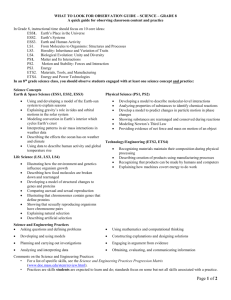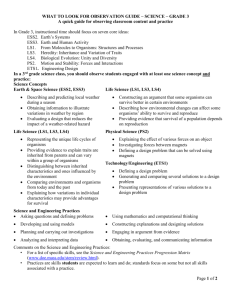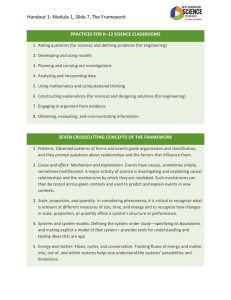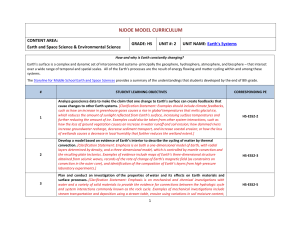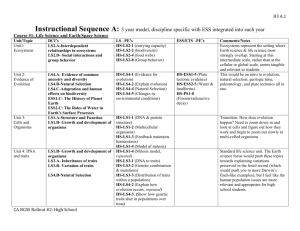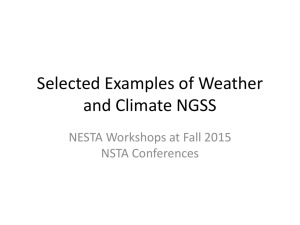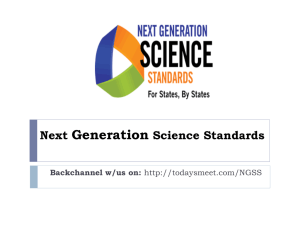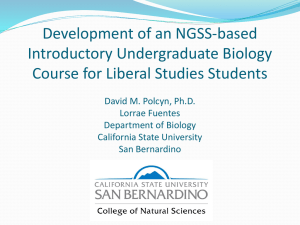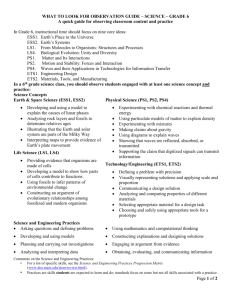8th Grade Pacing Guide - Fleming County Schools
advertisement
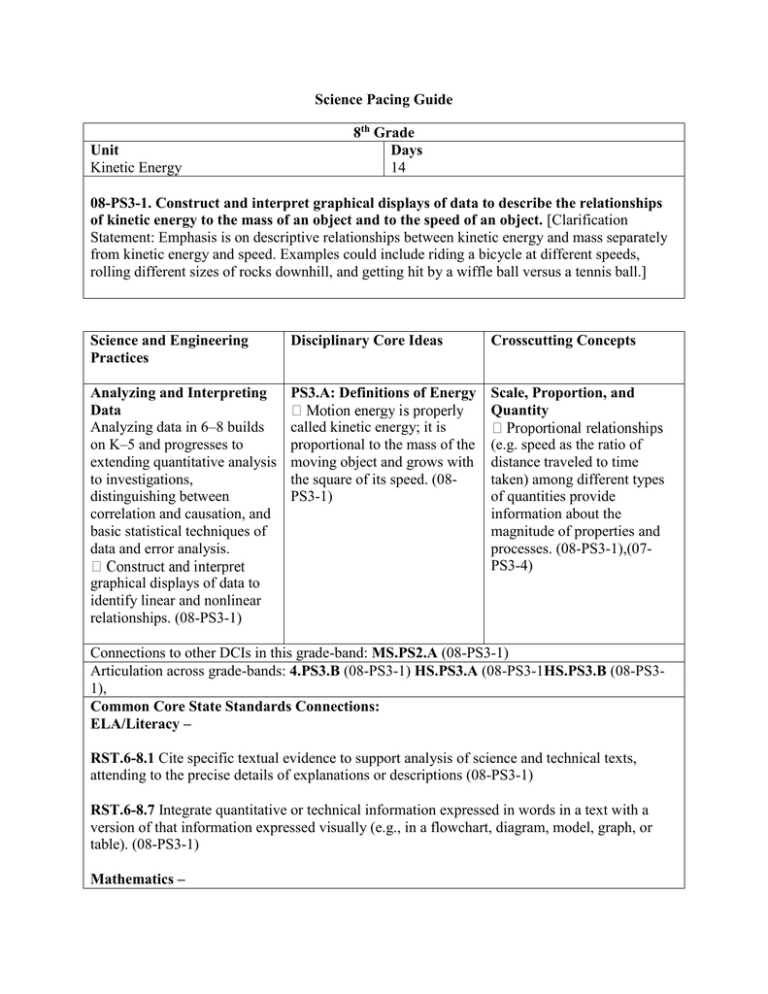
Science Pacing Guide Unit Kinetic Energy 8th Grade Days 14 08-PS3-1. Construct and interpret graphical displays of data to describe the relationships of kinetic energy to the mass of an object and to the speed of an object. [Clarification Statement: Emphasis is on descriptive relationships between kinetic energy and mass separately from kinetic energy and speed. Examples could include riding a bicycle at different speeds, rolling different sizes of rocks downhill, and getting hit by a wiffle ball versus a tennis ball.] Science and Engineering Practices Disciplinary Core Ideas Crosscutting Concepts Analyzing and Interpreting Data Analyzing data in 6–8 builds on K–5 and progresses to extending quantitative analysis to investigations, distinguishing between correlation and causation, and basic statistical techniques of data and error analysis. PS3.A: Definitions of Energy Scale, Proportion, and Quantity called kinetic energy; it is proportional to the mass of the (e.g. speed as the ratio of moving object and grows with distance traveled to time the square of its speed. (08taken) among different types PS3-1) of quantities provide information about the magnitude of properties and processes. (08-PS3-1),(07PS3-4) graphical displays of data to identify linear and nonlinear relationships. (08-PS3-1) Connections to other DCIs in this grade-band: MS.PS2.A (08-PS3-1) Articulation across grade-bands: 4.PS3.B (08-PS3-1) HS.PS3.A (08-PS3-1HS.PS3.B (08-PS31), Common Core State Standards Connections: ELA/Literacy – RST.6-8.1 Cite specific textual evidence to support analysis of science and technical texts, attending to the precise details of explanations or descriptions (08-PS3-1) RST.6-8.7 Integrate quantitative or technical information expressed in words in a text with a version of that information expressed visually (e.g., in a flowchart, diagram, model, graph, or table). (08-PS3-1) Mathematics – MP.2 Reason abstractly and quantitatively. (08-PS3-1) 6.RP.A.1Understand the concept of ratio and use ratio language to describe a ratio relationship between two quantities. (08-PS3-1) 6.RP.A.2Understand the concept of a unit rate a/b associated with a ratio a:b with b ≠ 0, and use rate language in the context of a ratio relationship. (08-PS3-1) 7.RP.A.2Recognize and represent proportional relationships between quantities. (08-PS3-1) 8.EE.A.1Know and apply the properties of integer exponents to generate equivalent numerical expressions. (08-PS3-1) 8.EE.A.2 Use square root and cube root symbols to represent solutions to equations of the form x2 = p and x3 = p, where p is a positive rational number. Evaluate square roots of small perfect squares and cube roots of small perfect cubes. Know that √2 is irrational. (08-PS3-1) 8.F.A.3Interpret the equation y = mx + b as defining a linear function, whose graph is a straight line; give examples of functions that are not linear. (08-PS3-1) Learning Targets: I Can …… 1. Calculate kinetic energy using a given formula. 2. Create and interpret graphs to explain the relationship between kinetic energy and mass/kinetic energy and speed. 3. Construct an explanation to support a claim. (Student Growth Goal. 4. I can Integrate quantitative or technical information expressed in words in a text with a version of that information expressed visually (e.g., in a flowchart, diagram, model, graph, or table). 5. I can Cite specific textual evidence to support analysis of science and technical texts, attending to the precise details of explanations or descriptions. (Note: This will be assessed formatively in this unit; not summatively) 6. I can follow precisely a multistep procedure when carrying out experiments, taking measurements, or performing technical tasks. *The performance expectations marked with an asterisk integrate traditional science content with engineering through a Practice or Disciplinary Core Idea. The section entitled “Disciplinary Core Ideas” is reproduced verbatim from A Framework for K-12 Science Education: Practices, CrossCutting Concepts, and Core Ideas. Integrated and reprinted with permission from the National Academy of Sciences. Science Pacing Guide Unit Heredity 8th Grade Days 20 08-LS3-1. Develop and use a model to describe why structural changes to genes (mutations) located on chromosomes may affect proteins and may result in harmful, beneficial, or neutral effects to the structure and function of the organism. [Clarification Statement: Emphasis is on conceptual understanding that changes in genetic material may result in making different proteins.] [Assessment Boundary: Assessment does not include specific changes at the molecular level, mechanisms for protein synthesis, or specific types of mutations.] 08-LS3-2. Develop and use a model to describe why asexual reproduction results in offspring with identical genetic information and sexual reproduction results in offspring with genetic variation. [Clarification Statement: Emphasis is on using models such as Punnett squares, diagrams, and simulations to describe the cause and effect relationship of gene transmission from parent(s) to offspring and resulting genetic variation.] 08-LS4-5. Gather and synthesize information about the technologies that have changed the way humans influence the inheritance of desired traits in organisms. [Clarification Statement: Emphasis is on synthesizing information from reliable sources about the influence of humans on genetic outcomes in artificial selection (such as genetic modification, animal husbandry, gene therapy); and, on the impacts these technologies have on society as well as the technologies leading to these scientific discoveries.] 08-LS4-4. Construct an explanation based on evidence that describes how genetic variations of traits in a population increase some individuals’ probability of surviving and reproducing in a specific environment. [Clarification Statement: Emphasis is on using simple probability statements and proportional reasoning to construct explanations 08-LS4-6. Use mathematical representations to support explanations of how natural selection may lead to increases and decreases of specific traits in populations over time. [Clarification Statement: Emphasis is on using mathematical models, probability statements, and proportional reasoning to support explanations of trends in changes to populations over time.] [Assessment Boundary: Assessment does not include Hardy Weinberg calculations.] Science and Engineering Practices Disciplinary Core Ideas Crosscutting Concepts Using Mathematics and Computational Thinking LS4.B: Natural Selection Cause and Effect Cause and effect Mathematical and computational thinking in 6–8 builds on K–5 experiences and progresses to identifying patterns in large data sets and using mathematical concepts to support explanations and arguments. the predominance of certain traits in a population, and the suppression of others. (08LS4-4) LS4.C: Adaptation selection acting over generations is one important representations to support process by which species scientific conclusions and change over time in response design solutions. (08-LS4-6) to changes in environmental conditions. Traits that support successful survival and Constructing Explanations reproduction in the new and Designing Solutions Constructing explanations and environment become more designing solutions in 6–8 common; those that do not builds on K–5 experiences and become less common. Thus, progresses to include the distribution of traits in a constructing explanations and population changes. (08-LS4designing solutions supported 6) by multiple sources of evidence consistent with LS1.B: Growth and scientific ideas, principles, and Development of Organisms theories. sexually or asexually, and construct an explanation for transfer their genetic real-world phenomena, information to their offspring. examples, or events. (08-LS4- (secondary to 08-LS3-2) 2) LS3.A: Inheritance of Traits that includes qualitative or quantitative relationships chromosomes of cells, with between variables that each chromosome pair describe phenomena. (08-LS4- containing two variants of 4) each of many distinct genes. Each distinct gene chiefly controls the production of Developing and Using specific proteins, which in Models Modeling in 6–8 builds on K– turn affects the traits of the 5 experiences and progresses individual. Changes to developing, using, and (mutations) to genes can result revising models to describe, in changes to proteins, which test, and predict more abstract can affect the structures and phenomena and design functions of the organism and systems. thereby change traits. (08- relationships may be used to predict phenomena in natural systems. (08-LS3-2) than one cause, and some cause and effect relationships in systems can only be described using probability. (07-LS1-4),(07-LS1-5),(08LS4-5) Structure and Function structures and systems can be visualized, modeled, and used to describe how their function depends on the shapes, composition, and relationships among its parts, therefore complex natural and designed structures/systems can be analyzed to determine how they function. (08-LS3-1) -----------------------------------------------Connections to Engineering, Technology, and Applications of Science Interdependence of Science, Engineering, and Technology led to important discoveries in virtually every field of science, and scientific discoveries have led to the development of entire industries and engineered systems. (08-LS4-5) --------------------------------------------Connections to Nature of Science Science Addresses Questions LS3-1) About the Natural and describe phenomena. (08-LS3of inherited traits Material World 1),(08-LS3-2) between parent and offspring arise from genetic differences describe consequences of that result from the subset of actions but does not make the Obtaining, Evaluating, and decisions that society takes. Communicating Information chromosomes (and therefore Obtaining, evaluating, and genes) inherited. (08-LS3-2) (08-LS4-5) communicating information in 6–8 builds on K–5 experiences LS3.B: Variation of Traits and progresses to evaluating the merit and validity of ideas organisms, each parent and methods. contributes half of the genes acquired (at random) by the information from multiple offspring. Individuals have appropriate sources and assess two of each chromosome and the credibility, accuracy, and hence two alleles of each possible bias of each gene, one acquired from each publication and methods used, parent. These versions may be and describe how they are identical or may differ from supported or not supported by each other. (08-LS3-2) evidence. (08-LS4-5) o variations that arise from sexual reproduction, genetic information can be altered because of mutations. Though rare, mutations may result in changes to the structure and function of proteins. Some changes are beneficial, others harmful, and some neutral to the organism. (08-LS3-1) LS4.B: Natural Selection humans have the capacity to influence certain characteristics of organisms by selective breeding. One can choose desired parental traits determined by genes, which are then passed on to offspring. (08-LS4-5) Connections to other DCIs in this grade-band: MS.LS2.A (08-LS4-4),(08-LS4-6); MS.LS2.C (08-LS4-6); MS.LS3.A (08-LS4-2),(08-LS4-4); MS.LS3.B (08-LS4-2),(08-LS4-4),(08-LS4-6); MS.ESS1.C (08-LS4-1),(08-LS4-2),(08-LS4-6); MS.ESS2.B (08-LS4-1) MS.LS1.A (08-LS3-1); MS.LS2.A (07-LS1-4),(07-LS1-5); MS.LS4.A (08-LS3-1) Articulation to DCIs across grade-bands: 3.LS3.A (07-LS1-5),(08-LS3-1),(08-LS3-2), 3.LS1.B (07-LS1-4),(07-LS1-5); 3.LS3.B (08-LS31),(08-LS3-2); 3.LS3.B(08-LS4-4); 3.LS4.A (08-LS4-1),(08-LS4-2); 3. LS4.B (08-LS4-4); 3.LS4.C (08-LS4-6); HS.LS1.A (08-LS3-1); HS.LS1.B (08-LS3-1),(08-LS3-2); HS.LS2.A (08LS4-4),(08-LS4-6); HS.LS2.C (08-LS4-6); HS.LS3.A (08-LS3-1),(HS.LS3.B (08-LS3-1),(08LS3-2),(08-LS4-5); HS.LS3.B (08-LS4-4),(08-LS4-6); HS.LS4.A (08-LS4-1),(08-LS4-2),(08LS4-3); HS.LS4.B (08-LS4-4),(08-LS4-6); HS.LS4.C (08-LS4-4),(08-LS4-6); ; HS.LS4.C (08LS4-5) HS.ESS1.C (08-LS4-1),(08-LS4-2) 08-LS3-2) Common Core State Standards Connections: ELA/Literacy – RST.6-8.1 Cite specific textual evidence to support analysis of science and technical texts, attending to the precise details of explanations or descriptions (08-LS4-1),(08-LS4-2),(08-LS43),(08-LS4-4) RST.6-8.4 Determine the meaning of symbols, key terms, and other domain-specific words and phrases as they are used in a specific scientific or technical context relevant to grades 6-8 texts and topics. (08-LS3-1),(08-LS3-2) RST.6-8.7 Integrate quantitative or technical information expressed in words in a text with a version of that information expressed visually (e.g., in a flowchart, diagram, model, graph, or table). (08-LS3-1),(08-LS3-2) RST.6-8.9 Compare and contrast the information gained from experiments, simulations, video, or multimedia sources with that gained from reading a text on the same topic. (08-LS4-3),(08LS4-4) WHST.6-8.2 Write informative/explanatory texts to examine a topic and convey ideas, concepts, and information through the selection, organization, and analysis of relevant content. (08-LS42),(08-LS4-4) WHST.6-8.8 Gather relevant information from multiple print and digital sources; assess the credibility of each source; and quote or paraphrase the data and conclusions of others while avoiding plagiarism and providing basic bibliographic information for sources. (08-LS4-5) WHST.6-8.9 Draw evidence from informational texts to support analysis, reflection, and research. (08-LS4-2),(08-LS4-4) SL.8.1 Engage effectively in a range of collaborative discussions (one-on-one, in groups, teacher-led) with diverse partners on grade 6 topics, texts, and issues, building on others’ ideas and expressing their own clearly. (08-LS4-2),(08-LS4-4) SL.8.4 Present claims and findings, emphasizing salient points in a focused, coherent manner with relevant evidence, sound valid reasoning, and well-chosen details; use appropriate eye contact, adequate volume, and clear pronunciation. (08-LS4-2),(08-LS4-4) Mathematics – MP.4 Model with mathematics. (08-LS4-6) 6.RP.A.1Understand the concept of a ratio and use ratio language to describe a ratio relationship between two quantities. (08-LS4-4),(08-LS4-6) 6.SP.B.5Summarize numerical data sets in relation to their context. (08-LS4-4),(08-LS4-6) 7.RP.A.2Recognize and represent proportional relationships between quantities. (08-LS4-4),(08LS4-6) Learning Targets: I Can …… 1. Develop and use a model to explain the outcomes of sexual and asexual reproduction. 2. Develop and use models to explain how mutations may be harmful, beneficial, or have no effect on an organism. 3. Use evidence to explain how the variation of traits increases some individuals’ probability of surviving and reproducing. 4. I can use math to explain how natural selection may increase or decrease specific traits over time. 5. Use information about the changes in technology to explain how humans can influence the inheritance of desired traits. *The performance expectations marked with an asterisk integrate traditional science content with engineering through a Practice or Disciplinary Core Idea. The section entitled “Disciplinary Core Ideas” is reproduced verbatim from A Framework for K-12 Science Education: Practices, CrossCutting Concepts, and Core Ideas. Integrated and reprinted with permission from the National Academy of Sciences. Unit Sensory Receptors 8th Grade Days 15 08-LS1-8. Gather and synthesize information that sensory receptors respond to stimuli by sending messages to the brain for immediate behavior or storage as memories. [Assessment Boundary: Assessment does not include mechanisms for the transmission of this information.] Science and Engineering Practices Disciplinary Core Ideas Crosscutting Concepts Obtaining, Evaluating, and Communicating Information Obtaining, evaluating, and communicating information in 6-8 builds on K-5 experiences and progresses to evaluating the merit and validity of ideas and methods. LS1.D: Information Processing Cause and Effect synthesize information from multiple appropriate sources and assess the credibility, accuracy, and possible bias of each publication and methods used, and describe how they are supported or not supported by evidence. (08-LS1-8) responds to different inputs (electromagnetic, mechanical, chemical), transmitting them as signals that travel along nerve cells to the brain. The signals are then processed in the brain, resulting in immediate behaviors or memories. (08-LS1-8) relationships may be used to predict phenomena in natural systems. (08-LS1-8) Connections to other DCIs in this grade-band: Articulation to DCIs across grade-bands: 4.LS1.D (08-LS1-8); HS.LS1.A (08-LS1-8) Common Core State Standards Connections: ELA/Literacy – WHST.6-8.8 Gather relevant information from multiple print and digital sources; assess the credibility of each source; and quote or paraphrase the data and conclusions of others while avoiding plagiarism and providing basic bibliographic information for sources. (08-LS1-8) Learning Targets: I Can …… 1. Use information to explain how sensory receptors respond to stimuli and send messages to the brain to store as memories. *The performance expectations marked with an asterisk integrate traditional science content with engineering through a Practice or Disciplinary Core Idea. The section entitled “Disciplinary Core Ideas” is reproduced verbatim from A Framework for K-12 Science Education: Practices, CrossCutting Concepts, and Core Ideas. Integrated and reprinted with permission from the National Academy of Sciences. 8th Grade Unit Days Fossils, Anatomical Structures, Embryological 16 Development 08-LS4-1. Analyze and interpret data for patterns in the fossil record that document the existence, diversity, extinction, and change of life forms throughout the history of life on Earth under the assumption that natural laws operate today as in the past. [Clarification Statement: Emphasis is on finding patterns of changes in the level of complexity of anatomical structures in organisms and the chronological order of fossil appearance in the rock layers.] [Assessment Boundary: Assessment does not include the names of individual species or geological eras in the fossil record.] 08-LS4-2. Apply scientific ideas to construct an explanation for the anatomical similarities and differences among modern organisms and between modern and fossil organisms to infer evolutionary relationships. [Clarification Statement: Emphasis is on explanations of the evolutionary relationships among organisms in terms of similarity or differences of the gross appearance of anatomical structures.] 08-LS4-3. Analyze displays of pictorial data to compare patterns of similarities in the embryological development across multiple species to identify relationships not evident in the fully formed anatomy. [Clarification Statement: Emphasis is on inferring general patterns of relatedness among embryos of different organisms by comparing the macroscopic appearance of diagrams or pictures.] [Assessment Boundary: Assessment of comparisons is limited to gross appearance of anatomical structures in embryological development.] Science and Engineering Practices Disciplinary Core Ideas Crosscutting Concepts Analyzing and Interpreting Data Analyzing data in 6–8 builds on K–5 experiences and progresses to extending quantitative analysis to investigations, distinguishing between correlation and causation, and basic statistical techniques of data and error analysis. LS4.A: Evidence of Common Ancestry and Diversity Patterns and their placement in chronological order (e.g., through the location of the sedimentary layers in which they are found or through radioactive dating) is known as the fossil record. It documents the existence, identify cause and effect relationships. (08-LS4-2) can be used to identify patterns in data. (08-LS4-1), (08-LS4-3) Connections to Nature of Science Scientific Knowledge Assumes an Order and to identify linear and nonlinear diversity, extinction, and relationships. (08-LS4-3) change of many life forms throughout the history of life to determine similarities and on Earth. (08-LS4-1) differences in findings. (08LS4-1) and differences between various organisms living today Constructing Explanations and between them and and Designing Solutions Constructing explanations and organisms in the fossil record, designing solutions in 6–8 enable the reconstruction of builds on K–5 experiences and evolutionary history and the progresses to include inference of lines of constructing explanations and evolutionary descent. (08designing solutions supported LS4-2) by multiple sources of evidence consistent with embryological development of scientific ideas, principles, and different species also reveals theories. similarities that show relationships not evident in the construct an explanation for fully-formed anatomy. (08real-world phenomena, LS4-3) examples, or events. (08-LS42) Consistency in Natural Systems objects and events in natural systems occur in consistent patterns that are understandable through measurement and observation. (08-LS4-1),(08-LS4-2) that includes qualitative or quantitative relationships between variables that describe phenomena. (08-LS44) --------------------------------------------Connections to Nature of Science Scientific Knowledge is Based on Empirical Evidence based upon logical and conceptual connections between evidence and explanations. (08-LS4-1) Connections to other DCIs in this grade-band: MS.LS2.A (08-LS4-4),(08-LS4-6); MS.LS2.C (08-LS4-6); MS.LS3.A (08-LS4-2),(08-LS4-4); MS.LS3.B (08-LS4-2),(08-LS4-4),(08-LS4-6); MS.ESS1.C (08-LS4-1),(08-LS4-2),(08-LS4-6); MS.ESS2.B (08-LS4-1) Articulation to DCIs across grade-bands: 3.LS3.B(08-LS4-4); 3.LS4.A (08-LS4-1),(08-LS4-2); 3. LS4.B (08-LS4-4); 3.LS4.C (08-LS46); HS.LS2.A (08-LS4-4),(08-LS4-6); HS.LS2.C (08-LS4-6); HS.LS3.B (08-LS4-4),(08-LS46); HS.LS4.A (08-LS4-1),(08-LS4-2),(08-LS4-3); HS.LS4.B (08-LS4-4),(08-LS4-6); HS.LS4.C (08-LS4-4),(08-LS4-6); HS.ESS1.C (08-LS4-1),(08-LS4-2) Common Core State Standards Connections: ELA/Literacy – RST.6-8.1 Cite specific textual evidence to support analysis of science and technical texts, attending to the precise details of explanations or descriptions (08-LS4-1),(08-LS4-2),(08-LS43),(08-LS4-4) RST.6-8.7 Integrate quantitative or technical information expressed in words in a text with a version of that information expressed visually (e.g., in a flowchart, diagram, model, graph, or table). (08-LS4-1),(08-LS4-3) RST.6-8.9 Compare and contrast the information gained from experiments, simulations, video, or multimedia sources with that gained from reading a text on the same topic. (08-LS4-3),(08LS4-4) WHST.6-8.2 Write informative/explanatory texts to examine a topic and convey ideas, concepts, and information through the selection, organization, and analysis of relevant content. (08-LS42),(08-LS4-4) WHST.6-8.9 Draw evidence from informational texts to support analysis, reflection, and research. (08-LS4-2),(08-LS4-4) SL.8.1 Engage effectively in a range of collaborative discussions (one-on-one, in groups, teacher-led) with diverse partners on grade 6 topics, texts, and issues, building on others’ ideas and expressing their own clearly. (08-LS4-2),(08-LS4-4) SL.8.4 Present claims and findings, emphasizing salient points in a focused, coherent manner with relevant evidence, sound valid reasoning, and well-chosen details; use appropriate eye contact, adequate volume, and clear pronunciation. (08-LS4-2),(08-LS4-4) Mathematics – 6.EE.B.6 Use variables to represent numbers and write expressions when solving a real-world or mathematical problem; understand that a variable can represent an unknown number, or, depending on the purpose at hand, any number in a specified set. (08-LS4-1),(08-LS4-2) Learning Targets: I Can …… 1. Analyze and interpret data to explain the patterns in fossil records. 2. Explain how the anatomical structures of organisms explain how organisms have evolved over time. 3. Compare and contrast pictorial data of the development of embryos of multiple species. 8th Grade Unit Days Ecosystem Components, Maintaining 20 Biodiversity, Minimizing Human Impact on Environment 08-LS2-4. Construct an argument supported by empirical evidence that changes to physical or biological components of an ecosystem affect populations. [Clarification Statement: Emphasis is on recognizing patterns in data and making warranted inferences about changes in populations, and on evaluating empirical evidence supporting arguments about changes to ecosystems.] 08-LS2-5. Evaluate competing design solutions for maintaining biodiversity and ecosystem services.* [Clarification Statement: Examples of ecosystem services could include water purification, nutrient recycling, and prevention of soil erosion. Examples of design solution constraints could include scientific, economic, and social considerations.] 08-ESS3-3. Apply scientific principles to design a method for monitoring and minimizing a human impact on the environment.* [Clarification Statement: Examples of the design process include examining human environmental impacts, assessing the kinds of solutions that are feasible, and designing and evaluating solutions that could reduce that impact. Examples of human impacts can include water usage (such as the withdrawal of water from streams and aquifers or the construction of dams and levees), land usage (such as urban development, agriculture, or the removal of wetlands), and pollution (such as of the air, water, or land).] Science and Engineering Practices Disciplinary Core Ideas Crosscutting Concepts Engaging in Argument from Evidence Engaging in argument from evidence in 6–8 builds on K–5 experiences and progresses to constructing a convincing argument that supports or refutes claims for either explanations or solutions about the natural and designed world(s). LS2.C: Ecosystem Dynamics, Functioning, and Resilience Stability and Change written argument supported by empirical evidence and scientific reasoning to support or refute an explanation or a model for a phenomenon or a in nature; their characteristics can vary over time. Disruptions to any physical or biological component of an ecosystem can lead to shifts in all its populations. (08-LS2-4) LS4.D: Biodiversity and Humans can influence humans’ resources, such as food, energy, and medicines, as well as ecosystem services that of a system might cause large changes in another part. (08LS2-4) Connections to Nature of Science Science Addresses Questions About the Natural and Material World describes consequence of actions but does not make the decisions that society takes. (08-LS2-5) Cause and Effect solution to a problem. (08LS2-4) humans rely on—for example, water purification and recycling. (secondary to 08LS2-5) classified as causal or correlational, and correlation solutions based on jointly does not necessarily imply developed and agreed-upon causation. (08-ESS3-3) design criteria. (08-LS2-5) ETS1.B: Developing Possible Influence of Science, Solutions Engineering, and Scientific Knowledge is Technology on Society and processes for evaluating Based on Empirical the Natural World solutions with respect to how Evidence well they meet the criteria and The uses of technologies and constraints of a problem. limitations on their use are common rules of obtaining (secondary to 08-LS2-5) driven by people’s needs, and evaluating empirical desires, and values; by the evidence. (08-LS2-4) ESS3.C: Human Impacts on findings of scientific research; and by differences in such Earth Systems factors as climate, natural Constructing Explanations significantly altered the resources, and economic and Designing Solutions Constructing explanations and biosphere, sometimes conditions. Thus technology designing solutions in 6–8 damaging or destroying use varies from region to builds on K–5 experiences and natural habitats and causing region and over time. (08progresses to include the extinction of other species. ESS3-2),(08-ESS3-3) constructing explanations and But changes to Earth’s designing solutions supported environments can have by multiple sources of different impacts (negative evidence consistent with and positive) for different scientific ideas, principles, and living things. (08-ESS3-3) theories. ientific principles populations and per-capita to design an object, tool, consumption of natural process or system. (08-ESS3- resources increase, so do the 3) negative impacts on Earth unless the activities and technologies involved are engineered otherwise. (08ESS3-3),(08-ESS3-4) Connections to other DCIs in this grade-band: MS.ESS2.B (08-LS4-1) MS.ESS2.,(08-LS2-4 MS.ESS3.C (08-LS2-5) MS.ESS1.C (08-LS41),(08-LS4-2),(08-LS4-6); MS.ESS3.A (08-LS2-4); MS.ESS3.C 08-LS2-4) MS.LS2.A (08ESS3-3),(08-ESS3-4); MS.LS2.A (08-LS4-4),(08-LS4-6); MS.LS2.C (08-ESS3-3),(08-ESS34); MS.LS2.C (08-LS4-6); MS.LS3.A (08-LS4-2),(08-LS4-4); MS.LS3.B (08-LS4-2),(08-LS44),(08-LS4-6); MS.LS4.C (08-LS2-4); MS.LS4.D (08-LS2-4) 2MS.LS4.D (08-ESS3-3),(08ESS3-4) MS.PS3.C (08-ESS3-2) Articulation to DCIs across grade-bands: 3.LS2.C 08-LS2-4); (08-ESS3-3),(08-ESS3-4); 3.LS3.B(08-LS4-4); 3.LS4.A (08-LS4-1),(08LS4-2); 3. LS4.B (08-LS4-4); 3.LS4.C (08-LS4-6); 3.LS4.D (08-LS2-4); (08-ESS3-3),(08ESS3-4); 3.ESS3.B (08-ESS3-2); 4.ESS3.B (08-ESS3-2); 5.ESS3.C (08-ESS3-3),(08-ESS3-4); HS.LS2.A 08-LS2-5);(08-ESS3-4); (08-LS4-4),(08-LS4-6); HS.LS2.B HS.LS2.C (08-LS4-6); (08-LS2-4); (08-LS2-5); (08-ESS3-3),(08-ESS3-4); HS.LS3.B (08-LS4-4),(08-LS4-6); HS.LS4.A (08-LS4-1),(08-LS4-2),(08-LS4-3); HS.LS4.B (08-LS4-4),(08-LS4-6)HS.LS4.C08LS4-4),(08-LS4-6); (08-LS2-4) (08-ESS3-3),(08-ESS3-4); LS4.D(08-LS2-4); (08-LS2-5); (08ESS3-3),(08-ESS3-4); HS.ESS1.C (08-LS4-1),(08-LS4-2) HS.ESS2.B (08-ESS3-2); HS.ESS2.C (08-ESS3-3); HS.ESS2.D (08-ESS3-2),(08-ESS3-3); HS.ESS2.E (08-LS2-4) (08ESS3-3),(08-ESS3-4);;HS.ESS3.A (08-LS2-5); (08-ESS3-4); HS.ESS3.B (08-LS2-4); (08ESS3-2); HS.ESS3.C (08-LS2-4) (08-ESS3-3),(08-ESS3-4); (08-LS2-5); HS.ESS3.D (08-LS25) (08-ESS3-2),(08-ESS3-3) Common Core State Standards Connections: ELA/Literacy – RST.6-8.1 Cite specific textual evidence to support analysis of science and technical texts. (07LS1-6),(06-LS2-1),(08-LS2-4) RI.8.8 Trace and evaluate the argument and specific claims in a text, assessing whether the reasoning is sound and the evidence is relevant and sufficient to support the claims. (08-LS2-4) WHST.6-8.1 Write arguments to support claims with clear reasons and relevant evidence. (08LS2-4) WHST.6-8.2 Write informative/explanatory texts to examine a topic and convey ideas, concepts, and information through the selection, organization, and analysis of relevant content. (08-LS42),(08-LS4-4) WHST.6-8.7 Conduct short research projects to answer a question (including a self-generated question), drawing on several sources and generating additional related, focused questions that allow for multiple avenues of exploration. (08-ESS3-3) WHST.6-8.8 Gather relevant information from multiple print and digital sources; assess the credibility of each source; and quote or paraphrase the data and conclusions of others while avoiding plagiarism and providing basic bibliographic information for sources. (08-ESS3-3) WHST.6-8.9 Draw evidence from informational texts to support analysis, reflection, and research. (08-LS4-2),(08-LS4-4) Mathematics – 6.RP.A.1Understand the concept of a ratio and use ratio language to describe a ratio relationship between two quantities. (08-ESS3-3),(08-ESS3-4) 6.EE.B.6 Use variables to represent numbers and write expressions when solving a real-world or mathematical problem; understand that a variable can represent an unknown number, or, depending on the purpose at hand, any number in a specified set. (08-LS4-1),(08-LS4-2) 7.RP.A.2Recognize and represent proportional relationships between quantities. (08-ESS33),(08-ESS3-4) 7.EE.B.4Use variables to represent quantities in a real-world or mathematical problem, and construct simple equations and inequalities to solve problems by reasoning about the quantities. (08-ESS3-2),(08-ESS3-3),(08-ESS3-4) Learning Targets: I Can …… 1. Use evidence to explain how changes to physical or biological parts of an ecosystem will affect the population. 2. Evaluate competing design solutions for maintaining biodiversity and ecosystem services. 3. Design a method to monitor and minimize human impact on the environment. 8th Grade Unit Days Distribution of Minerals, Population effects 20 natural resources 08-ESS3-1. Construct a scientific explanation based on evidence for how the uneven distributions of Earth’s mineral, energy, and groundwater resources are the result of past and current geoscience processes. [Clarification Statement: Emphasis is on how these resources are limited and typically non-renewable, and how their distributions are significantly changing as a result of removal by humans. Examples of uneven distributions of resources as a result of past processes include but are not limited to petroleum (locations of the burial of organic marine sediments and subsequent geologic traps), metal ores (locations of past volcanic and hydrothermal activity associated with subduction zones), and soil (locations of active weathering and/or deposition of rock).] 08-ESS3-4. Construct an argument supported by evidence for how increases in human population and per-capita consumption of natural resources impact Earth’s systems. [Clarification Statement: Examples of evidence include grade-appropriate databases on human populations and the rates of consumption of food and natural resources (such as freshwater, mineral, and energy). Examples of impacts can include changes to the appearance, composition, and structure of Earth’s systems as well as the rates at which they change. The consequences of increases in human populations and consumption of natural resources are described by science, but science does not make the decisions for the actions society takes.] Science and Engineering Practices Constructing Explanations and Designing Solutions Constructing explanations and designing solutions in 6–8 builds on K–5 experiences and progresses to include constructing explanations and designing solutions supported by multiple sources of evidence consistent with scientific ideas, principles, and theories. Disciplinary Core Ideas Crosscutting Concepts Cause and Effect ESS3.A: Natural Resources Earth’s land, ocean, atmosphere, and biosphere for many different resources. Minerals, fresh water, and biosphere resources are limited, and many are not renewable or replaceable over human lifetimes. These resources are distributed unevenly around the planet as explanation based on valid and a result of past geologic reliable evidence obtained processes. (08-ESS3-1) from sources (including the students’ own experiments) ESS3.C: Human Impacts on relationships may be used to predict phenomena in natural or designed systems. (08ESS3-1) Connections to Engineering, Technology, and Applications of Science Influence of Science, Engineering, and Technology on Society and the Natural World on natural resources and has both short and long-term consequences, positive as well and the assumption that theories and laws that describe the natural world operate today as they did in the past and will continue to do so in the future. (08-ESS3-1) Engaging in Argument from Evidence Engaging in argument from evidence in 6–8 builds on K–5 experiences and progresses to constructing a convincing argument that supports or refutes claims for either explanations or solutions about the natural and designed world(s). written argument supported by empirical evidence and scientific reasoning to support or refute an explanation or a model for a phenomenon or a solution to a problem. (08ESS3-4) Earth Systems populations and per-capita consumption of natural resources increase, so do the negative impacts on Earth unless the activities and technologies involved are engineered otherwise. (08ESS3-3),(08-ESS3-4) as negative, for the health of people and the natural environment. (08-ESS3-1) Cause and Effect relationships may be used to predict phenomena in natural or designed systems. (08ESS3-4) Connections to Engineering, Technology, and Applications of Science Influence of Science, Engineering, and Technology on Society and the Natural World on natural resources and has both short and long-term consequences, positive as well as negative, for the health of people and the natural environment. (08-ESS3-4) Connections to Nature of Science Science Addresses Questions About the Natural and Material World describe consequences of actions but does not make the decisions that society takes. (08-ESS3-4) Connections to other DCIs in this grade-band: MS.PS1.A (08-ESS3-1); MS.PS1.B (08-ESS3-1)MS.ESS2.D (08-ESS3-1); MS.PS3.C (08-ESS3-2); MS.LS2.A (08-ESS3-3),(08-ESS3-4); MS.LS2.C (08-ESS3-3),(08ESS3-4); MS.LS4.D (08-ESS3-3),(08-ESS3-4) Articulation to DCIs across grade-bands: 4.PS3.D (08-ESS3-1); A (08-ESS3-4) 3.LS2.C (08-ESS3-3),(08-ESS3-4); 3.LS4.D (08-ESS33),(08-ESS3-4); 4.ESS3.A (08-ESS3-1); 3.ESS3.B (08-ESS3-2); 4.ESS3.B (08-ESS3-2); 5.ESS3.C (08-ESS3-3),(08-ESS3-4); HS.LS2.A (08-ESS3-4); HS.LS1.C (08-ESS3-1); HS.LS2.C (08-ESS3-3),(08-ESS3-4); HS.LS4.C (08-ESS3-3),(08-ESS3-4); HS.LS4.D (08ESS3-3),(08-ESS3-4); HS.PS3.B )08-ESS3-1; HS.ESS2.A (08-ESS3-1); HS.ESS2.B (08-ESS3- 1); (08-ESS3-2); HS.ESS2.C (08-ESS3-1); (08-ESS3-3); ESS2.D (08-ESS3-2),(08-ESS3-3); HS.ESS2.E (08-ESS3-3),(08-ESS3-4) HS.ESS3.A (08-ESS3-1) HS.ESS3.D (08-ESS3-2),(08ESS3-3) Common Core State Standards Connections: ELA/Literacy – RST.6-8.1 Cite specific textual evidence to support analysis of science and technical texts. (08ESS3-1) WHST.6-8.2 Write informative/explanatory texts to examine a topic and convey ideas, concepts, and information through the selection, organization, and analysis of relevant content. (08-ESS31) WHST.6-8.7 Conduct short research projects to answer a question (including a self-generated question), drawing on several sources and generating additional related, focused questions that allow for multiple avenues of exploration. (08-ESS3-3) WHST.6-8.8 Gather relevant information from multiple print and digital sources; assess the credibility of each source; and quote or paraphrase the data and conclusions of others while avoiding plagiarism and providing basic bibliographic information for sources. (08-ESS3-3) WHST.6-8.9 Draw evidence from informational texts to support analysis, reflection, and research. (08-ESS3-1) Mathematics – 6.EE.B.6 Use variables to represent numbers and write expressions when solving a real-world or mathematical problem; understand that a variable can represent an unknown number, or, depending on the purpose at hand, any number in a specified set. (08-ESS3-1) 7.EE.B.4Use variables to represent quantities in a real-world or mathematical problem, and construct simple equations and inequalities to solve problems by reasoning about the quantities. (08-ESS3-1) 6.RP.A.1Understand the concept of a ratio and use ratio language to describe a ratio relationship between two quantities. (08-ESS3-3),(08-ESS3-4) 7.RP.A.2Recognize and represent proportional relationships between quantities. (08-ESS33),(08-ESS3-4) 6.EE.B.6 Use variables to represent numbers and write expressions when solving a real-world or mathematical problem; understand that a variable can represent an unknown number, or, depending on the purpose at hand, any number in a specified set. (08-ESS3-2),(08-ESS3-3),(08ESS3-4) 7.EE.B.4Use variables to represent quantities in a real-world or mathematical problem, and construct simple equations and inequalities to solve problems by reasoning about the quantities. (08-ESS3-2),(08-ESS3-3),(08-ESS3-4) Learning Targets: I Can …… 1. Use evidence to explain how the uneven distribution of minerals, energy, and groundwater resources are the result of past and current geosciences processes. 2. Use evidence to explain how the increase in human population and the use of resources impact Earth’s systems. Unit Climate Change 8th Grade Days 20 08-ESS3-5. Ask questions to clarify evidence of the factors that have caused the rise in global temperatures over the past century. [Clarification Statement: Examples of factors include human activities (such as fossil fuel combustion, cement production, and agricultural activity) and natural processes (such as changes in incoming solar radiation or volcanic activity). Examples of evidence can include tables, graphs, and maps of global and regional temperatures, atmospheric levels of gases such as carbon dioxide and methane, and the rates of human activities. Emphasis is on the major role that human activities play in causing the rise in global temperatures.] Science and Engineering Practices Asking Questions and Defining Problems Asking questions and defining problems in 6–8 builds on K– 5 experiences and progresses to specifying relationships between variables, clarify arguments and models. and clarify evidence of an argument. (08-ESS3-5) Disciplinary Core Ideas Crosscutting Concepts Stability and Change ESS3.D: Global Climate Change the release of greenhouse gases from burning fossil fuels, are major factors in the current rise in Earth’s mean surface temperature (global warming). Reducing the level of climate change and reducing human vulnerability to whatever climate changes do occur depend on the understanding of climate science, engineering capabilities, and other kinds of knowledge, such as understanding of human behavior and on applying that knowledge wisely in decisions and activities. (08-ESS3-5) disturbed either by sudden events or gradual changes that accumulate over time. (08ESS3-5) Connections to other DCIs in this grade-band: MS.PS3.A (08-ESS3-5) Articulation to DCIs across grade-bands: HS.PS3.B (08-ESS3-5); HS.PS4.B (08-ESS3-5); HS.ESS2.A 08-ESS3-5 HS.ESS2.D (08ESS3-5); HS.ESS3.C (08-ESS3-5); HS.ESS3.D (08-ESS3-5) Common Core State Standards Connections: ELA/Literacy – RST.6-8.1 Cite specific textual evidence to support analysis of science and technical texts. (08ESS3-5) Mathematics – MP.2 Reason abstractly and quantitatively. (08-ESS3-5) 6.EE.B.6 Use variables to represent numbers and write expressions when solving a real-world or mathematical problem; understand that a variable can represent an unknown number, or, depending on the purpose at hand, any number in a specified set. (08-ESS3-5) 7.EE.B.4Use variables to represent quantities in a real-world or mathematical problem, and construct simple equations and inequalities to solve problems by reasoning about the quantities. (08-ESS3-5) Learning Targets: I Can …… 1. Ask questions to clarify evidence of factors that have caused the rise in global temperatures over the past century. Unit Natural Hazards 8th Grade Days 20 08-ESS3-2. Analyze and interpret data on natural hazards to forecast future catastrophic events and inform the development of technologies to mitigate their effects. [Clarification Statement: Emphasis is on how some natural hazards, such as volcanic eruptions and severe weather, are preceded by phenomena that allow for reliable predictions, but others, such as earthquakes, occur suddenly and with no notice, and thus are not yet predictable. Examples of natural hazards can be taken from interior processes (such as earthquakes and volcanic eruptions), surface processes (such as mass wasting and tsunamis), or severe weather events (such as hurricanes, tornadoes, and floods). Examples of data can include the locations, magnitudes, and frequencies of the natural hazards. Examples of technologies can be global (such as satellite systems to monitor hurricanes or forest fires) or local (such as building basements in tornado-prone regions or reservoirs to mitigate droughts).] Science and Engineering Practices Analyzing and Interpreting Data Analyzing data in 6–8 builds on K–5 experiences and progresses to extending quantitative analysis to investigations, distinguishing between correlation and causation, and basic statistical techniques of data and error analysis. a to determine similarities and differences in findings. (08ESS3-2) Disciplinary Core Ideas Crosscutting Concepts ESS3.B: Natural Hazards Patterns natural hazards in a region, combined with an understanding of related geologic forces can help forecast the locations and likelihoods of future events. (08-ESS3-2) can be used to identify patterns in data. (08-ESS3-2) Influence of Science, Engineering, and Technology on Society and the Natural World and limitations on their use are driven by people’s needs, desires, and values; by the findings of scientific research; and by differences in such factors as climate, natural resources, and economic conditions. Thus technology use varies from region to region and over time. (08ESS3-2),(08-ESS3-3) Connections to other DCIs in this grade-band: MS.PS3.C (08-ESS3-2); MS.LS2.A (08-ESS3-3),(08-ESS3-4); MS.LS2.C (08-ESS3-3),(08ESS3-4); MS.LS4.D (08-ESS3-3),(08-ESS3-4) Articulation to DCIs across grade-bands: 3.LS2.C (08-ESS3-3),(08-ESS3-4); 3.LS4.D (08-ESS3-3),(08-ESS3-4); 3.ESS3.B (08-ESS3-2); 4.ESS3.B (08-ESS3-2); 5.ESS3.C (08-ESS3-3),(08-ESS3-4); HS.LS2.A (08-ESS3-4); HS.LS2.C (08-ESS3-3),(08-ESS3-4); HS.LS4.C (08-ESS3-3),(08-ESS3-4); HS.LS4.D (08ESS3-3),(08-ESS3-4); HS.ESS2.B (08-ESS3-2); HS.ESS2.C (08-ESS3-3); HS.ESS2.D (08ESS3-2),(08-ESS3-3); HS.ESS2.E (08-ESS3-3),(08-ESS3-4); HS.ESS3.A (08-ESS3-4); HS.ESS3.B (08-ESS3-2); HS.ESS3.C (08-ESS3-3),(08-ESS3-4); HS.ESS3.D (08-ESS3-2),(08ESS3-3) Common Core State Standards Connections: ELA/Literacy – RST.6-8.1 Cite specific textual evidence to support analysis of science and technical texts. (08ESS3-2),(08-ESS3-4) RST.6-8.7 Integrate quantitative or technical information expressed in words in a text with a version of that information expressed visually (e.g., in a flowchart, diagram, model, graph, or table). (08-ESS3-2) Mathematics – MP.2 Reason abstractly and quantitatively. (08-ESS3-2) 6.EE.B.6 Use variables to represent numbers and write expressions when solving a real-world or mathematical problem; understand that a variable can represent an unknown number, or, depending on the purpose at hand, any number in a specified set. (08-ESS3-2),(08-ESS3-3),(08ESS3-4) 7.EE.B.4Use variables to represent quantities in a real-world or mathematical problem, and construct simple equations and inequalities to solve problems by reasoning about the quantities. (08-ESS3-2),(08-ESS3-3),(08-ESS3-4) Learning Targets: I Can …… 1. Analyze and interpret data on natural hazards to predict future catastrophic events and inform the development of technologies to mitigate their effects.
